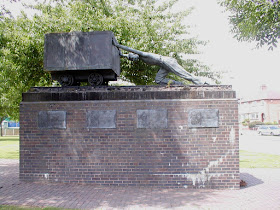Kent's Lane Colliery c. 1903
COLLIERY FATALITY AT
SILVERDALE
Youth Killed by Fall
of Roof
Mr. H. W. Adams (Coroner) held an inquest at the New Inn,
Knutton on Friday afternoon, on the body of Arthur Heath (16) a taker-off, of
6, Arthur Street, Knutton, who was killed by a fall of roof at Kent’s Lane
Colliery, Silverdale, belonging to the Shelton Iron , Steel and Coal Company,
Ltd, on Tuesday.
There were present at the enquiry Mr. P.S. Lea ((H.M.
Inspector of Mines), Mr. W. H. Abberley (representing the Shelton Company), Mr.
R.H. Moon, from the office of Messrs Hollinshead and Moody (on behalf of the
relatives of the deceased), Mr. J. W. Sumnall (Secretary of the North
Staffordshire Shotlighters’ and Firemen’s Association) and Mr. J. Cocks (agent to
the Shelton Company).
[Illegible] by Robert Heath, an iron worker, who stated that
the deceased, his son, had worked at the Kent’s Lane Pit 18 months.
Mr. W. Malbon, manager at the Silverdale Collieries,
produced a plan showing the scene of the accident, which happened in the South
East District (No. [illegible] jig). Witness stated that he visited the place
at 9.15 pm – about an hour after the accident. A fall had taken place at the
bottom of the jig in the Great Row Seam reeling out a post and two stretchers.
The fall would be approximately a ton, one lump weighing approximately 10 cwt.
It had come from a slit which could not have been seen before the accident. The
place had been sufficiently timbered. A goth1 might have caused the
accident; the district suffered occasionally from goths.
Arthur Davies, a taker-off, of 44, Goose Street, Newcastle,
said he was working along with the deceased at the time of the accident.
Witness was taking his tub out first, the deceased following with his load.
Witness got through the brattice2, when he heard some stuff coming
down. On going back he found that the deceased was under the fall. Witness
picked up the deceased’s lamp, which was extinguished, and ran for assistance.
Witness had heard a goth about a quarter of an hour prior to the accident.
Joshua Jones, colliery foreman, of 31, Newcastle Street,
Silverdale spoke to making an examination of the place about an hour and a half
before the accident. He thought it was perfectly safe, and would have been
satisfied to work there himself.
P.S.C.A. Clarke of Silverdale, described the nature of the
injuries. There was an extensive wound under the right armpit, bruises on the
neck and face and the ribs were crushed.
The Coroner registered a verdict of “Accidental death”.
Mr. Cocks, on behalf of the owners of the colliery, and the
Coroner expressed sympathy with the relatives of the deceased.
A couple of mining terms in the report require some
explanation for the layman.
1 goth: A
sudden outburst of coal at the working face accompanied by a loud report. As a
rule the coal and stone are projected from the face in a very shattered, and
often powdered, condition. The outburst is due to the settlement of the roof
producing a state of strain in the coal or its roof, or floor, eventuating in
the sudden rupture, which is termed ‘goth’.
2 Brattice:
a division or partition in a shaft, heading or other underground working place
to direct air to a specific point, often to dilute flammable or noxious gases.
It could also be used to divide the place or a shaft into two parts, one for
the ingress of fresh air and the other for the egress of the used air. A
brattice could be constructed of wood, brick or stonework, or heavy-duty
tightly woven (sometimes tarred) cloth nailed to a timber frame or timber
boarding.
Arthur Heath killed on 6th December 1921 at the age of just 16 was my Great Uncle.
My Grandfather, James Heath, seven at the time of his older brother's death, used to tell me how he used to earn pocket money cleaning and applying dubbing to Arthur's football boots as he had some talent as a player. He was on Port Vale's books and was expected to make his debut at around the time of the accident.
I am sure you would agree that the report above, published in The Sentinel, is extremely matter of fact, only the last line hints at the human tragedy of this pit collapse. This is an indication of how common place fatalities in Britain's coal mines were and also just how conditioned members of the mining community were to such occurrences. Sudden death was indeed part and parcel of a miner's experience.
Whilst preparing to post this piece I did some digging (thankfully not in a mine, but from the safety of my computer chair) into the Silverdale (Kent's Lane) Colliery. The first mine shafts were sunk in 1830 after which the colliery started to mine both ironstone (an iron rich rock once used for smelting) as well as coal. The principal beneficiary of the mining conducted at the Kent's Lane site was the nearby Knutton forge, but a little more on that later. These two local industries, mining and iron production were the mainstays of employment in the area (now really an area of Newcastle-Under-Lyme) for well over a hundred years. Silverdale or Kent's Lane Colliery finally closed in 1998, the last surviving mine in North Staffordshire.
In 1996 a monument was raised to the memory of all those miners who lost their lives in the process of extracting coal at the Silverdale Colliery over its operational life time. There names are recorded on three slate plaques on the plinth that supports the sculpture of a young man pushing a coal laden rail truck. Arthur is commemorated on the third plaque. It is such a shame that my Grandfather was not aware that such a memorial was being planned. Alas he died in February 1995.
The Silverdale Coal Miners Memorial
The list of man's in the third plaque including Arthur Heath (circled)
Sadly, I do not have a photograph of Arthur. However, you will recall that earlier I mentioned Knutton Forge, that took most of the coal extracted from the Kent's Lane Colliery to fire its furnaces. Well, Robert Heath, Arthur's father (and therefore my Great Grandfather) named as being present at the Coroner's Inquiry, worked at Knutton Forge and I go have a photograph of him from a book of old postcards of Newcastle-Under-Lyme, given to me by my Grandmother (his daughter-in-Law) in the 1980's.
A group of Knutton Forge workers c. 1896
(Robert Heath is second from the right)
Robert Heath
Knutton Forge c. 1925 (a photograph fairy contemporary with Arthur's brief time at the Kent's Lane Colliery)
Robert Heath died on 13th January 1949 and is interred in Knutton Cemetery.


















